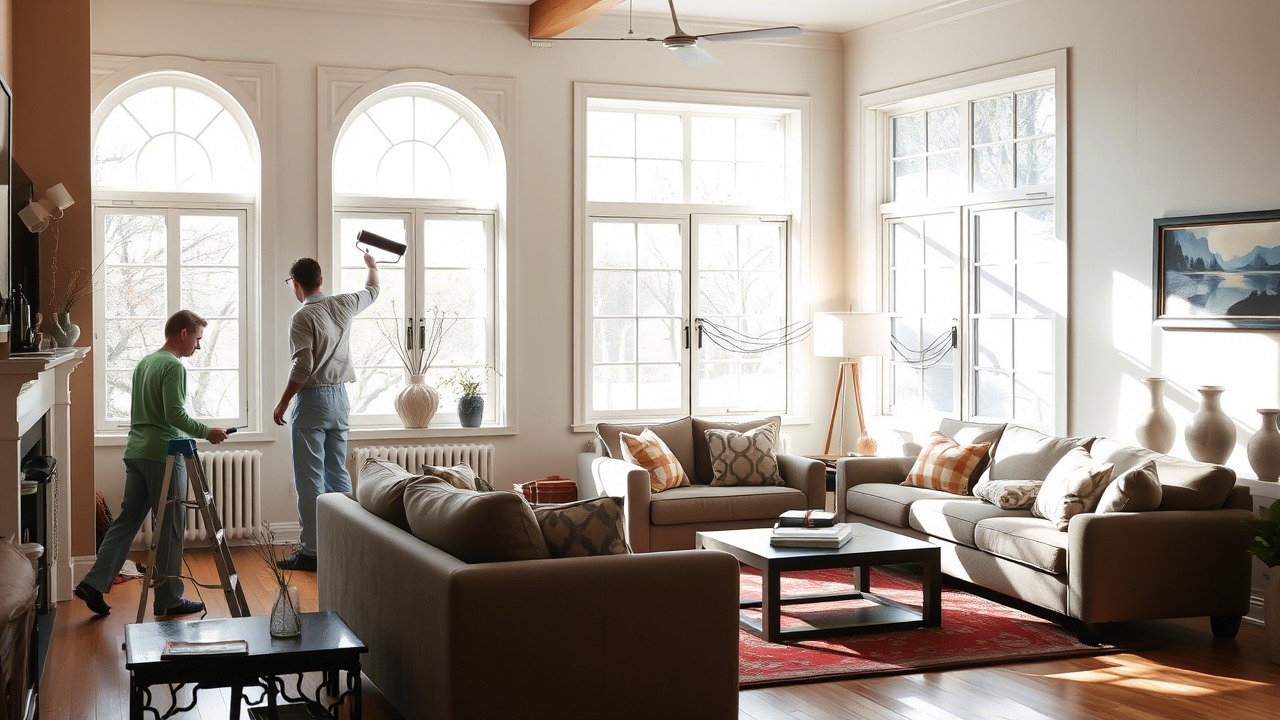Best Elastomeric Paint for Stucco – A Complete Guide to Durable, Protective Finishes
Stucco is a popular exterior material for homes, especially in regions with dry climates. It’s durable and offers excellent protection against the elements, but like all materials, it can start to show wear and tear over time. Whether you’re refreshing your stucco’s appearance or protecting it from the weather, using the right paint is crucial. For stucco surfaces, elastomeric paint is often the best choice. Elastomeric paint is a high-performance, flexible coating that provides superior protection for stucco, making it resistant to cracking, peeling, and water damage.
We’ll explore the best elastomeric paints for stucco, their benefits, and how to choose the perfect product for your home.
What Is Elastomeric Paint?
Elastomeric paint is a flexible, thick coating specifically designed to expand and contract with the surface it’s applied to, making it ideal for materials like stucco, concrete, and masonry. It’s often used in areas that experience extreme weather conditions, such as high humidity, intense sunlight, or rapid temperature fluctuations.
Key Features of Elastomeric Paint:
- Elasticity: Elastomeric paint is known for its ability to stretch and move with the material it’s applied to, reducing the risk of cracking and peeling.
- Waterproofing: It creates a watertight seal, making it resistant to moisture and preventing water infiltration that can lead to mold, mildew, and structural damage.
- Durability: Designed to last for many years, elastomeric paint resists fading, weathering, and cracking, providing long-term protection.
- Thick and Cohesive: Elastomeric paint is much thicker than regular paint, which helps it to fill in hairline cracks and provide a smooth, uniform finish.
Why Choose Elastomeric Paint for Stucco?
Stucco, by nature, is porous and can absorb moisture, which can lead to problems like cracking and water damage. Elastomeric paint addresses these issues by creating a flexible, waterproof barrier. The benefits of elastomeric paint for stucco include:
- Crack Resistance: Elastomeric paint can stretch up to 300% of its original size, allowing it to bridge small cracks in the stucco and prevent new ones from forming.
- Protection from Weather: It provides exceptional resistance to rain, snow, and UV rays, making it an ideal choice for homes in areas with harsh climates.
- Long-Lasting Finish: The thick, durable coating will maintain its color and texture for years, saving you from frequent touch-ups or repainting.
- Improved Insulation: Some elastomeric paints contain reflective properties, which can help improve energy efficiency by reducing heat absorption and keeping your home cooler.
Top Elastomeric Paints for Stucco
Choosing the right elastomeric paint for your stucco can be a bit overwhelming, as there are many brands and formulations on the market. Here’s a look at some of the best elastomeric paints for stucco, each offering unique benefits:
1. DuraFlex Elastomeric Coating by Sherwin-Williams
Best For: Superior protection and long-term durability
Sherwin-Williams is a well-known name in the paint industry, and their DuraFlex Elastomeric Coating is one of the best options for stucco surfaces. This product is designed to provide exceptional durability while maintaining flexibility to prevent cracks and fading over time.
Key Features:
- Waterproof: Provides excellent protection against water damage, preventing moisture from seeping into the stucco.
- Crack Resistant: Can bridge cracks up to 1/8 inch in width, making it perfect for stucco surfaces prone to minor cracking.
- UV Protection: Offers UV protection to keep your stucco looking vibrant for years.
- Breathable: Allows moisture vapor to escape, preventing mold and mildew buildup.
Pros:
- Long-lasting and highly durable
- Ideal for homes in climates with fluctuating temperatures
- Available in a wide range of colors
Cons:
- Premium price point compared to other elastomeric paints
- Requires proper surface preparation for best results
2. Behr Premium Elastomeric Masonry, Stucco, and Brick Paint
Best For: Budget-conscious homeowners
Behr Premium Elastomeric Masonry, Stucco, and Brick Paint is a more affordable option that doesn’t sacrifice performance. This paint is perfect for homeowners looking to protect their stucco surfaces while sticking to a budget.
Key Features:
- Waterproofing: Provides a waterproof barrier to protect against moisture and water infiltration.
- Crack Bridging: Flexible enough to bridge small cracks and prevent new ones from forming.
- Mildew Resistant: Helps protect against mold and mildew buildup in damp areas.
- UV Resistant: Maintains the integrity of color even in direct sunlight.
Pros:
- Affordable and widely available
- Easy to apply with a brush, roller, or sprayer
- Available in a variety of colors and finishes
Cons:
- May require multiple coats for optimal coverage
- Not as long-lasting as some premium elastomeric paints
3. LaHabra Elastomeric Coating
Best For: Premium quality and performance
LaHabra Elastomeric Coating is a high-end elastomeric paint that’s highly regarded for its exceptional weather resistance and ability to adhere to stucco surfaces. It’s perfect for those looking for premium protection and an aesthetically pleasing finish.
Key Features:
- Superior Flexibility: Bridges hairline cracks and expands with the stucco as it moves, providing a flexible, durable finish.
- Water Repellent: Protects against moisture and humidity, preventing the growth of mold and mildew.
- UV Protection: Guards against sun damage, preserving the color and finish of your stucco.
- Rich Finish: Provides a smooth, matte finish that enhances the aesthetic appeal of your stucco.
Pros:
- Excellent crack-bridging ability
- High-performance product that lasts for years
- Great for high-humidity areas
Cons:
- Higher price point compared to mid-range elastomeric paints
- Requires proper surface preparation for best results
4. KILZ L211101 Exterior Elastomeric Paint
Best For: Value and versatility
KILZ L211101 Exterior Elastomeric Paint is a versatile, cost-effective option that works well for both stucco and masonry surfaces. Known for its weather-resistant qualities, it provides excellent protection against rain and UV rays.
Key Features:
- Weather Resistant: Protects against rain, snow, and other weather conditions, helping to keep your stucco dry and safe.
- Crack Resistant: Expands and contracts with the surface, preventing cracks from appearing on your stucco.
- Easy Application: Dries quickly and can be applied with a roller or sprayer for a smooth finish.
- Fade Resistant: Maintains color integrity over time, even in direct sunlight.
Pros:
- Affordable, with good performance for the price
- Easy to apply and clean up
- Versatile for use on other exterior surfaces, like brick and concrete
Cons:
- May need touch-ups after several years of exposure
- Requires more preparation than premium paints
5. Zinsser Perma-White Exterior Paint
Best For: Mildew resistance and low-maintenance finish
Zinsser Perma-White Exterior Paint is a great choice for stucco that’s frequently exposed to moisture, as it offers excellent mildew resistance and long-lasting performance.
Key Features:
- Mildew Resistant: Built-in protection against mold and mildew growth, making it ideal for humid environments.
- Low Maintenance: The paint resists dirt and stains, reducing the need for frequent cleaning or repainting.
- Waterproof: Provides a water-resistant finish to protect your stucco from the elements.
- UV Protection: Protects the color and finish from sun damage.
Pros:
- Low-maintenance and easy to clean
- Good for areas with high humidity and moisture
- Excellent mildew resistance
Cons:
- Not as flexible as some elastomeric paints
- Requires surface preparation for best results
How to Apply Elastomeric Paint on Stucco
For the best results when applying elastomeric paint to stucco, follow these steps:
1. Prepare the Surface
Proper preparation is crucial for elastomeric paint. Start by cleaning the stucco thoroughly with a pressure washer to remove dirt, debris, and old paint. If there are any cracks, fill them in with a stucco patch or filler, and let the surface dry completely before painting.
2. Apply Primer (if necessary)
Some elastomeric paints are self-priming, but it’s always best to check the product instructions. If a primer is recommended, use one designed for masonry or stucco surfaces to improve adhesion and coverage.
3. Choose the Right Tools
For elastomeric paint, a high-quality roller or sprayer is ideal. A roller with a thick nap (3/4 inch or higher) will help you apply the paint evenly. If you’re using a sprayer, ensure it’s set to the correct pressure to avoid overspray.
4. Apply the Paint
Elastomeric paint is thick, so apply it in thin, even coats. Start from the top of the wall and work your way down. Allow each coat to dry completely before applying the next. Typically, two coats are recommended for maximum durability.
5. Let It Cure
Elastomeric paint takes longer to cure than regular paint, so be patient. Allow the paint to cure for at least 24–48 hours before exposing it to harsh weather.
Conclusion
Elastomeric paint is the best choice for stucco because of its flexibility, weather resistance, and long-lasting durability. When selecting the right elastomeric paint, consider factors such as the level of weather protection, ease of application, and price. Brands like Sherwin-Williams, Behr, and LaHabra provide top-quality options that can ensure your stucco surfaces remain protected for years to come. With proper preparation and application, elastomeric paint will offer a vibrant, durable finish that enhances the look and longevity of your home’s exterior.


Leave a Reply